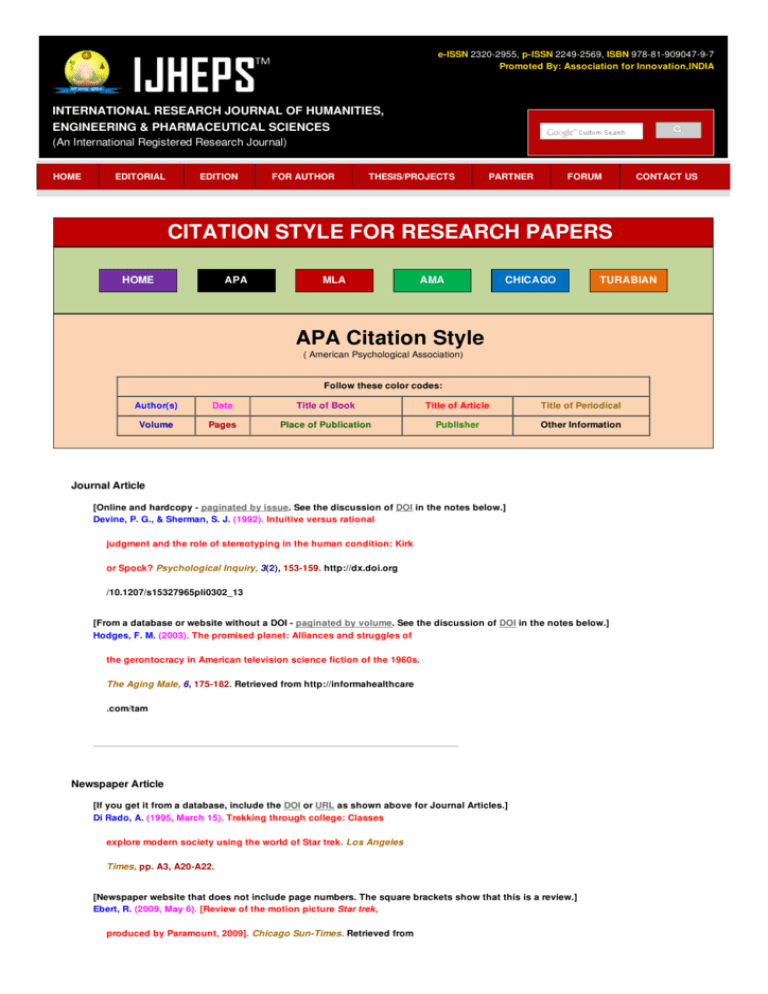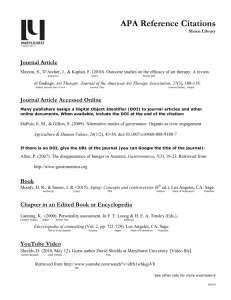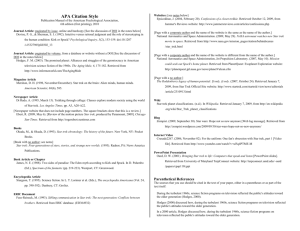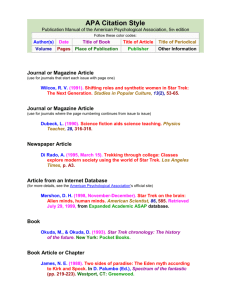APA Citation Style
advertisement

e-ISSN 2320-2955, p-ISSN 2249-2569, ISBN 978-81-909047-9-7 Promoted By: Association for Innovation,INDIA INTERNATIONAL RESEARCH JOURNAL OF HUMANITIES, ENGINEERING & PHARMACEUTICAL SCIENCES (An International Registered Research Journal) HOME EDITORIAL EDITION FOR AUTHOR THESIS/PROJECTS PARTNER FORUM CONTACT US CITATION STYLE FOR RESEARCH PAPERS HOME APA MLA AMA CHICAGO TURABIAN APA Citation Style ( American Psychological Association) Follow these color codes: Author(s) Date Title of Book Title of Article Title of Periodical Volume Pages Place of Publication Publisher Other Information Journal Article [Online and hardcopy - paginated by issue. See the discussion of DOI in the notes below.] Devine, P. G., & Sherman, S. J. (1992). Intuitive versus rational judgment and the role of stereotyping in the human condition: Kirk or Spock? Psychological Inquiry, 3(2), 153-159. http://dx.doi.org /10.1207/s15327965pli0302_13 [From a database or website without a DOI - paginated by volume. See the discussion of DOI in the notes below.] Hodges, F. M. (2003). The promised planet: Alliances and struggles of the gerontocracy in American television science fiction of the 1960s. The Aging Male, 6, 175-182. Retrieved from http://informahealthcare .com/tam Newspaper Article [If you get it from a database, include the DOI or URL as shown above for Journal Articles.] Di Rado, A. (1995, March 15). Trekking through college: Classes explore modern society using the world of Star trek. Los Angeles Times, pp. A3, A20-A22. [Newspaper website that does not include page numbers. The square brackets show that this is a review.] Ebert, R. (2009, May 6). [Review of the motion picture Star trek, produced by Paramount, 2009]. Chicago Sun-Times. Retrieved from http://rogerebert.suntimes.com Magazine Article Mershon, D. H. (1998, November/December). Star trek on the brain: Alien minds, human minds. American Scientist, 86(6), 585. [If you get it from a database, include the DOI or URL as shown above for Journal Articles.] [If you get it from a magazine's website that does not include volume or page numbers, follow the example above for Newspapers.] Books Okuda, M., & Okuda, D. (1993). Star trek chronology: The history of the future. New York, NY: Pocket Books. [Book with no author; see notes] Star trek: Four generations of stars, stories, and strange new worlds. (1995). Radnor, PA: News America Publications. [Online, with a DOI] Michaud, M. A. G. (2007). Contact with alien civilizations: Our hopes and fears about encountering extraterrestrials. http://dx.doi.org /10.1007/978-0-387-68618-9 [Online from a database - without a DOI - Do not include the full URL] Anijar, K. (2000). Teaching toward the 24th century: Star trek as social curriculum. Retrieved from http://www.ebrary.com Include only the homepage of the database: eBook Collection: http://search.ebscohost.com ebrary: http://www.ebrary.com Gale Virtual Reference Library: http://www.gale.cengage.com Google Books: http://books.google.com [Ebook reader, Kindle, Nook, etc.] Okuda, M., Okuda, D., & Mirek, D. (2011). The Star trek encyclopedia [Kindle DX version]. Retrieved from http://www.amazon.com Book Article or Chapter James, N. E. (1988). Two sides of paradise: The Eden myth according to Kirk and Spock. In D. Palumbo (Ed.), Spectrum of the fantastic (pp. 219-223). Westport, CT: Greenwood. [Online from a database - without a DOI - Do not include the full URL] Cohen, S. (2002). Klingons are the same wherever you go. In N. Stafford (Ed.), Trekkers: True stories by fans for fans (pp. 140-142). Retrieved from http://www.ebrary.com Encyclopedia Article Sturgeon, T. (1995). Science fiction. In L. T. Lorimer et al. (Eds.), The encyclopedia Americana (Vol. 24, pp. 390-392). Danbury, CT: Grolier. [Online from a database - without a DOI - Do not include the full URL] Tauber, S. (2008). Star trek. In W. A. Darity Jr. (Ed.), International encyclopedia of the social sciences (2nd ed., Vol. 8, p. 99). Retrieved from http://www.gale.cengage.com [Online from a website - with no author, no date, no page, and no editor. If some of this information is available, include it as shown above.] Star trek. (n.d.). In Encyclopaedia Britannica. Retrieved from http://www.britannica.com/EBchecked/topic/563557/Star-Trek [Include the complete URL] [Wiki - include the retrieval date in addition to the page's date, if there is one] Star trek planet classifications. (n.d.). In Wikipedia. Retrieved January 7, 2009, from http://en.wikipedia.org/wiki/Star_Trek_planet _classifications [Include the complete URL] ERIC Document Fuss-Reineck, M. (1993). Sibling communication in Star trek: The next generation: Conflicts between brothers. Retrieved from ERIC database. (ED364932) Dissertation Boyd, K. G. (2001). Imagined spaces: Entertainment and utopia in science fiction films and television series of the 1980s and 1990s (Doctoral dissertation). Retrieved from ProQuest Dissertations & Theses Full Text database. (Dissertation No. 3024161) Websites: [see notes below] Epsicokhan, J. (2004, February 20). Confessions of a closet trekkie. Retrieved October 12, 2009, from Jammer's Reviews website: http://www.jammersreviews.com/articles/confessions.php [Page with a corporate author and the name of the website is the same as the name of the author.] National Aeronautics and Space Administration. (2009, May 28). NASA astronaut watches new Star trek movie in space. Retrieved from http://www.nasa.gov/mission_pages/station/behindscenes/star_trek .html [Page with a corporate author and the name of the website is different from the name of the author.] National Aeronautics and Space Administration, Jet Propulsion Laboratory. (2007, May 10). Mission could seek out Spock's home planet. Retrieved from PlanetQuest: Exoplanet Exploration website: http://planetquest.jpl.nasa.gov/news/planetVulcan.cfm [Page with a no author.] The Roddenberry legacy of human potential: If only, if only. (2007, October 24). Retrieved January 7, 2009, from Star Trek Official Site website: http://www.startrek.com/startrek/view/news/editorials /article/2310913.html Company and Industry Reports: from Hoovers, Mergent, Value Line, Standard & Poor's NetAdvantage, etc. [Include the URL of the database's homepage instead of the complete link.] Industry custom report: Advertising agencies. (2013, February 25). Retrieved from Hoover's website: http://subscriber.hoovers.com /H/home/index.html [You have the option of using the database's name as the author instead of the publisher.] Hoover's Inc. (2013, February 25). Industry custom report: Advertising agencies. Retrieved from http://subscriber.hoovers.com/H/home /index.html [Report with no date.] Microsoft Corporation profile. (n.d.). Retrieved April 16, 2013, from Hoover's website: http://subscriber.hoovers.com/H/home /index.html [Spreadsheet data.] Microsoft: Quarterly income statement [Data file]. (2013). Retrieved from Hoover's website: http://subscriber.hoovers.com/H/home /index.html [A company's annual report, 10k, etc.] Microsoft Corporation. (2012). 2012 annual report. Retrieved from Mergent Online website: http://www.mergentonline.com /basicsearch.php Streaming Video [Movie or documentary from a streaming service - use the URL of the homepage] Pommer, E. (Producer), & Lang, F. (Director). (2012). Metropolis [Video file]. Retrieved from http://search.alexanderstreet.com (Original release date 1927) [If the original date of the movie is different from the video's date, include it at the end with no period.] [If you use the transcript that comes with the video, put the phrase Video transcript in the place of Video file.] [Series episode or webisode from a streaming service - use the URL of the homepage] Kosa, F. (Writer), & Cohen, D. J. (Director). (2011). The hunt for ringed planets [Television series episode]. In L. C. Tarantino & D. J. Cohen (Executive Producers), The universe. Retrieved from http://search .alexanderstreet.com (Original release date 2009) [YouTube or a website - include the full date and full URL] Crusade2267. (2006, November 02). For the uniform: One fan's obsession with Star trek, part 1 [Video file]. Retrieved from http:// www.youtube.com/watch?v=ul5q4PTME-M [If the producer's and director's names are available, include them as shown above.] [If the video is part of a series, include the information as shown above.] Blog Zompist. (2009, September 30). Star wars: Hope not so new anymore [Blog post]. Retrieved from http://zompist.wordpress.com /2009/09/30/star-wars-hope-not-so-new-anymore/ PowerPoint Presentation Oard, D. W. (2001). Bringing Star trek to life: Computers that speak and listen [PowerPoint slides]. Retrieved from University of Maryland TerpConnect website: http://terpconnect.umd.edu/~oard /papers/cpsp118t.ppt Parenthetical References The sources that you use should be cited in the text of your paper, either in a parentheses or as part of the text itself: During the turbulent 1960s, science fiction programs on television reflected the public's attitudes toward the older generation (Hodges, 2000). Hodges (2000) discussed how, during the turbulent 1960s, science fiction programs on television reflected the public's attitudes toward the older generation. In a 2000 article, Hodges discussed how, during the turbulent 1960s, science fiction programs on television reflected the public's attitudes toward the older generation. The references above refer to the entire source in a general way. If you are referring to a specific part of the source - or quoting exactly - include the specific page number(s) of that part: (Hodges, 2000, p. 179) (Devine & Sherman, 1992, pp. 156-157) (National Aeronautics and Space Administration, Jet Propulsion Laboratory, 2007, para. 3) [document has a corporate author] ("The Roddenberry Legacy," 2007, paras. 5-6) [document has no author; see notes] (Star Trek: Four Generations, 1995, pp. 63-66) [document has no author; see notes] ("Star Trek Planet Classifications," n.d., Other Classes section, para. 2) [document has no author; see notes] (Crusade2267, 2006, 3:36) [for videos and other recordings, include the timestamp of the section that you are referring to] Sources with three through five authors: (Kirk, Spock, McCoy, & Scott, 1966, p. 1701) [for the first time you cite it] (Kirk et al., 1966, p. 1701) [for all other times you cite it] Sources with six authors or more: (Picard et al., 1987, p. 1701d) [for every time you cite it, but include up to seven authors in the full reference. If there are more, include the first six, followed by an ellipse (...) followed by the last of the names.] Notes Doublespace all lines. Indent the second and following lines 5 to 7 spaces or one half inch. Use one inch margins and Times New Roman 12-point font. Do not justify. Arrange the items on your reference list alphabetically by the author's last name, letter by letter, interfiling books, articles, etc. Items with no author are interfiled in this list by the first significant word of the title. Use only the initials of the authors' first (and middle) names. If no author is given, start with the title and then the date. Note that some authors on the internet use a screen name instead of their real name and that an organization can also be an author (a "corporate author"). See examples under books, websites, and blogs. Article titles, book titles, and webpage titles: capitalize only the first word of the title and subtitle. (Capitalize all significant words of periodical titles, database titles and website titles.) If the journal (or magazine) begins each issue with page one (paginated by issue), include the issue number (not italicized) if one is provided. If the journal continues the page numbering from issue to issue throughout the volume (paginated by volume), do not include it. If a book is not the first edition, include the edition number in parentheses after the title. See the example for Tauber under Encyclopedia Article. DOI: Digital Object Identifier is a string of numbers (and/or letters) assigned to individual journal articles, books, book articles, and other publications. Include the DOI for items that you retrieve both online and (if possible) in hardcopy. The database may provide the DOI as part of the citation, or you may have to look at the top or bottom of the first page of the article to find it. When the 6th edition of the Publication Manual was published in 2010, it originally indicated that the DOI should be preceded by "doi:" (ex. doi:10.1207/s15327965pli0302_13). Your readers could then go to http://www.doi.org and use the DOI to locate the item. In 2011, it was decided that the DOI should be preceded by the complete URL, "http://dx.doi.org/" (ex. http://dx.doi.org/10.1207/s15327965pli0302_13). Both formats are still acceptable. Use the one that your source uses. If you retrieve an article from a website or database, and it does not have a DOI, go to http://crossref.org and type in the article's name to see if they can provide the DOI. If that does not work: Journals: Include the URL of the journal's homepage at the publisher's website (not the direct link to the article or the database). You may have to use a search engine to find this website. If the URL to the journal's homepage is too long and complicated, use the URL of the publisher's homepage. The only time that you should include the full URL to the article would be when the article is difficult to find from the journal's homepage. These are judgment calls that you will have to make. Books: If you retrieve the text of a book from a database (such as ebrary, Google Books, eBook Collection, or Gale Virtual Reference Library) - and there is no DOI - include the URL of the databases' homepage, not the complete URL or the URL of the publisher's homepage. If you retrieve the text of a book from a website or if the book is available only online, then include the complete URL. Do not include the database's name unless the item is available in only that one database. The most likely places where you will encounter this among our online resources would be older articles from JSTOR, ERIC documents from ERIC, and dissertations from ProQuest Dissertations & Theses Full-Text. See the examples for a dissertation or ERIC document. Older hardcopy publications will not have a DOI, and it can be left out. Websites: If no author is given, start with the title and then the date. Note that some authors on the internet use a screen name instead of their real name and that an organization can also be an author (a "corporate author"). If possible, include the month and day that the page was created. If a webpage is part of a larger website, do not italicize the title of the page. If the webpage is an independent document on the website, do italicize the title of the page. This is also a judgment call that you will have to make. If you are not sure, do not italicize. If a webpage is likely to change over time, such as a wiki or personal website, include the date that you looked at the page. Webpages that provide journal articles, books, or reports from publishing companies, professional associations, and government agencies are less likely to change and do not require retrieval dates. This is also a judgment call that you will have to make. If the date the page was created is not given, use (n.d.). See examples under Encyclopedia Article. If the name of the website is the same as the name of the author, you do not need to include it a second time. This is especially likely to happen with the websites for government agencies and professional associations (see the examples for National Aeronautics and Space Administration). If the name of the website is obvious from the URL, you do not need to include it (another judgment call). If the URL does not fit on one line, divide it before any punctuation marks (except for the "http://"). If you are citing the web version of a hardcopy source, format it the same way that you would the hardcopy source and include the relevant retrieval information. Parenthetical References: If there is no author, use the first few words of the title. Unlike citations in the reference list, capitalize all significant words. Article, chapter, and webpage titles are placed in quotation marks. Book, periodical, report, and brochure titles are placed in italics. Note that an organization can also be an author (a "corporate author"). If two authors have the same last name, include the first initial(s). Use only the year, even if the full citation in the reference list includes the month and day. If you cite the same source a second time in the same paragraph, you do not need to mention the year a second time. If there are no page numbers, you can count the paragraph numbers or list the name of a section or leave this information out if neither of these is practical. The rules concerning a title within a title are not displayed above in order to avoid confusing people. In these examples, Star trek would be italicized if it appears in the non-italicized title of an article and not italicized if it appears in the italicized title of a book (reverse italicization). See the example for Ebert under newspaper. A little bit of additional information is available on the official website, APA Style.org. Impact Factor | Social Media | Online Issue | Contact us | Admin | Web Mail © 2011 International Research By Shashank Tiwari. IJHEPS by Association for Innovation is licensed under a Creative Commons Attribution 4.0 International License. Based on a work at www.ijheps.org. Permissions beyond the scope of this license may be available at www.ijheps.org Design By Innctech Solution





